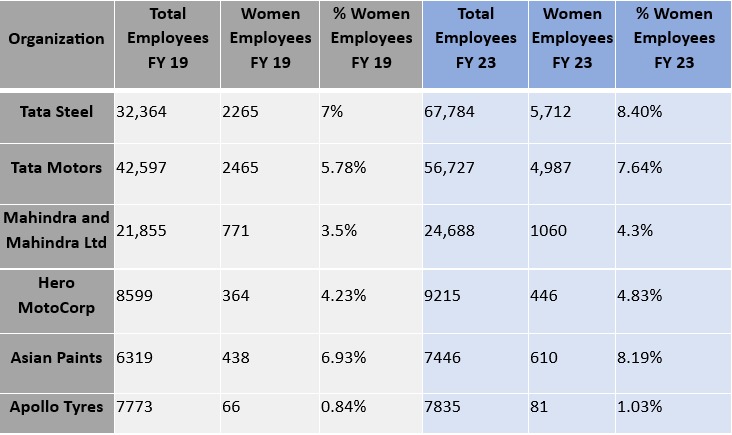
During a recent Gender workshop with one of the Tata groups, our research led to the below finding.
The importance of gender diversity in the workplace has grown recently, with many firms making a concerted effort to foster a more welcoming atmosphere. We will explore their efforts to achieve gender parity and diversity in this blog post by looking at the data that shows their development.
With an increase in women over the years definitely, the company’s overall growth has been growing.

The Status of Women
Board of Directors: The Tata Group’s Board of Directors featured a notable representation of women as of my last update in 2022. The presence of female directors on the boards of several Tata companies contributes to the diversity of leadership. The percentage may differ between the various Tata subsidiaries.
Workforce composition: Tata, Mahindra, Hero, Asian Paints, Apollo Tyres etc have improved the proportion of women in its workforce overall. Women have been actively recruited at all levels, from entry-level jobs to senior management positions.
Leadership Roles: The firms have established goals to increase the proportion of women in leadership positions. To attain a more balanced ratio in historically male-dominated industries, they have been increasing the proportion of women in top management positions.
Analyzing the Data to Determine Progress
Even though the precise numbers could alter in the future, the firm’s dedication to disclosing its gender diversity initiatives must be emphasized. Their consistent release of reports and updates offers valuable insights into their progress, enabling stakeholders to monitor their progress towards advancing gender equality.
The women’s percentage increased in 2023 compared to 2019 at Tata Steel from 7% to 8.4%, Tata Motors from 5.78% to 7.64%, Mahindra and Mahindra Ltd. from 3.5% to 4.3%, Hero MotoCorp from 4.23% to 4.83%, Asian Paints from 6.93% to 8.19%, and Apollo Tyres from 0.84% to 1.03%.
Difficulties and Continual Work
Creating a supportive work environment, addressing unconscious bias, and promoting work-life balance are just a few of the difficulties associated with promoting gender diversity. The firms are aware of these difficulties and are still funding projects to get past them.
Equal Pay: They have continuously stressed the value of paying workers equally for work done, working to close the gender pay gap in the company.
Initiatives for Diversity and Inclusion: They have launched several initiatives to promote an inclusive work environment, including networking opportunities for female employees, diversity training, and mentorship programs.
Flexible Work Arrangements: To assist women in advancing their careers, the groups have implemented flexible work arrangements because they recognize the importance of work-life balance.
The Tata Group’s and other manufacturing firm’s commitment to gender diversity are demonstrated by their continuous efforts to enhance the representation of women in their workforce and their dedication to transparency. Their initiatives offer a solid foundation for ongoing progress in achieving a balanced gender ratio at all organizational levels, even though the specific statistics may have changed since my last update. They demonstrate their dedication to gender equality by leading by example and regularly updating their advancements. This encourages other businesses to take similar steps to establish diverse and inclusive workplaces.
Please reach out to us for any queries on Gender Inclusion Strategies.
For more blogs and articles, visit our official website. Contact us for workshops and queries related to POSH, EAP (Employee Assistance Program,) and Diversity and Inclusion.




